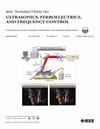Pre-Charged Collapse-Mode Capacitive Micromachined Ultrasonic Transducer (CMUT) Receivers for Efficient Power Transfer
IF 3
2区 工程技术
Q1 ACOUSTICS
IEEE transactions on ultrasonics, ferroelectrics, and frequency control
Pub Date : 2024-12-25
DOI:10.1109/TUFFC.2024.3523179
引用次数: 0
Abstract
Capacitive micromachined ultrasonic transducers (CMUTs) offer several advantages over standard lead zirconate titanate (PZT) transducers, particularly for implantable devices. To eliminate their typical need for an external bias voltage, we embedded a charge storage layer in the dielectric. The objective of this study was to evaluate the performance of plasma-enhanced chemical vapor deposition (PECVD) Si3N4 and atomic layer deposition (ALD) Al2O3 as materials for the charge storage layer and two different dielectric layer thicknesses, focusing on their application as receivers in a wireless power transfer link. Capacitance–voltage (CV) measurements revealed that Si3N4 has a higher charge storage capacity compared to Al2O3. Additionally, a thicker dielectric layer between the bottom electrode and the charge storage layer (Bdiel) improved both charge trapping and retention, as assessed in dynamic accelerated lifetime transmit (TX)-mode tests. We then analyzed the power conversion performance of the fabricated CMUTs through both simulations and experiments. We performed extensive modeling based on an equivalent circuit derived from electrical impedance measurements of the fabricated CMUTs. The model was used to predict the power conversion efficiency under various conditions, including the charging field strength, the operating frequency, and parasitic series resistance. Power transfer experiments at 1- and 2.4-MHz recorded efficiencies exceeding 80% with an optimally matched load and up to 54% with a purely resistive load. Results confirmed that, with optimal load matching, the efficiency of different CMUT variants is comparable, indicating that the optimal variant should be selected based on additional criteria, such as charge retention time.用于高效功率传输的预充电折叠模式电容式微机械超声换能器(CMUT)接收器
电容式微机械超声换能器(cmut)与标准锆钛酸铅(PZT)换能器相比具有几个优点,特别是对于可植入设备。为了消除它们对外部偏置电压的典型需求,我们在电介质中嵌入了电荷存储层。本研究的目的是评估等离子体增强化学气相沉积(PECVD) Si3N4和原子层沉积(ALD) Al2O3作为电荷存储层和两种不同介电层厚度材料的性能,重点研究它们作为无线电力传输链路接收器的应用。电容电压(CV)测量结果表明,与Al2O3相比,Si3N4具有更高的电荷存储容量。此外,在动态加速寿命传输(TX)模式测试中评估,底部电极和电荷存储层(Bdiel)之间较厚的介电层改善了电荷捕获和保留。然后通过仿真和实验分析了所制备的cmut的功率转换性能。我们基于制造的cmut的电阻抗测量得出的等效电路进行了广泛的建模。利用该模型预测了充电场强、工作频率、寄生串联电阻等条件下的功率转换效率。功率传输实验在1和2.4 mhz记录效率超过80%的最佳匹配负载和高达54%的纯电阻负载。结果证实,在最优负载匹配下,不同CMUT变体的效率具有可比性,这表明应根据电荷保留时间等附加标准选择最优变体。
本文章由计算机程序翻译,如有差异,请以英文原文为准。
求助全文
约1分钟内获得全文
求助全文
来源期刊
CiteScore
7.70
自引率
16.70%
发文量
583
审稿时长
4.5 months
期刊介绍:
IEEE Transactions on Ultrasonics, Ferroelectrics and Frequency Control includes the theory, technology, materials, and applications relating to: (1) the generation, transmission, and detection of ultrasonic waves and related phenomena; (2) medical ultrasound, including hyperthermia, bioeffects, tissue characterization and imaging; (3) ferroelectric, piezoelectric, and piezomagnetic materials, including crystals, polycrystalline solids, films, polymers, and composites; (4) frequency control, timing and time distribution, including crystal oscillators and other means of classical frequency control, and atomic, molecular and laser frequency control standards. Areas of interest range from fundamental studies to the design and/or applications of devices and systems.

 求助内容:
求助内容: 应助结果提醒方式:
应助结果提醒方式:


